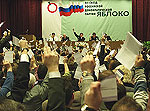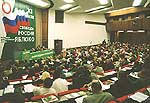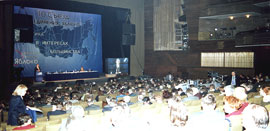A working day in the Irkutsk region, or how to get to the shore of Baikal and not be able to see Baikal
Nikolai Rybakov’s Facebook page, 8.08.2021
IRKUTSK
 Photo by the Yabloko Press Service
Photo by the Yabloko Press Service
In the morning Anna Shlomina, our candidate for the State Duma elections, the founder of the public organisation for the protection of animals “ZooZabota”, showed me the Centre for sterilisation of pets, which works in the city at discounted prices. The main problem is the lack of drugs that are required to perform operations and treat animals. Sometimes they can only be obtained in Moscow and then sent to Irkutsk. Not only people but also animals suffer from sanctions and bans on the imports of foreign medicines. I wanted to write “four-legged”, but deleted it. Because after the clinic, Anna and I went to a shelter for homeless animals.
Maybe you have read in previous publications about the animals shelter in Novosibirsk. Some of the animals there are disabled. In the Irkutsk shelter, all animals are disabled. If you see a dog on four legs, consider yourself a lucky one. Dogs and cats, injured in the street, hit by cars – get into this house. It is absolutely clear that if it were not for the shelter, these animals would have died long ago. To be honest, animal rights activists have a hard time – the state does not provide assistance in this work. Although this is exactly the direction in which the state can fully rely on volunteer organisations, transfer funding to them and leave to itself only control. In the shelter I remembered a German shepard Kai, he is just in the photo – how he wants to be stroked, so that someone would shale his paw, he is not wicked at all, just stern at first glance.
After visiting the animals shelter, I gave an interview to Ust-Kut24 Novosti media, discussed the Yabloko party’s programme, the problem of Usoliekhimprom [chemical enterprise] and environmental problems of the region. Then, together with Grigory Gribenko and the team, we went to the cities of the Irkutsk region.
SHELEKHOV
Photo by the Yabloko Press Service
This is the hometown of our Grigory. The city is only 59 years old. It was named in honour of Grigory Shelekhov, the navigator who was the first to make the trade route from Irkutsk to Alaska. The population is 45,000 people, most of whom work at the Irkutsk Aluminum Plant, the Cable Plant and the only one in Russia – the Silicon Plant. The city was built by the Soviet young people of the 1960s. Shelekhov is included in the list of cities with critical air pollution. People leave the city for other regions of the country. Unfortunately, this tendency is characteristic of the Irkutsk region as a whole. In the city, we talked with voters, our volunteers handed out the party’s programme, talked with journalists from the city media.
At the local market, we met Klavdia Yevgenievna Kruglova. She is 90 years old and still grows and sells berries on the market. Klavdia Yevgenievna watches [television] political talk shows, supports and even before our arrival decided to vote for Yabloko and convince her large family of this. We wished her good health, and she promised to come to the elections on 19 September and vote for us.
SLYUDYANKA
Photo by the Yabloko Press Service
On the way from Shelekhov to Slyudyanka we stopped for lunch at a roadside cafe with Buryat cuisine. Its owner Lyudmila (if politely translated) spoke about the difficulties of small business, especially during the pandemic. Then she fed us a delicious lunch and, as a sign of friendship, she went out to see us off wearing a national dress. In Slyudyanka, together with Pavel Kharitonenko, a civic activist, founder of the New Russia – Free Country social movement, who is running for the State Duma from the district that this city belongs to, we met with local residents who came to meet with us.
Slyudyanka was founded in 1899 and stands on the shore of Lake Baikal. The city is famous for the production of cembra nuts, and there are also stone processing enterprises. However, the biggest pride, which the residents who came to the meeting immediately told me about, is that the only railway station in the world completely faced with Baikal white and pink marble is located in Slyudyanka. That is, in St. Petersburg there is the Marble Palace, and in Slyudyanka there is the Marble Station. They are linked by the [royal] Romanov family.
The station was opened in 1904, opposite the station there is the Church of St. Nicholas the Wonderworker, Innocentius and the Martyr Tatiana. According to local legend, the history of the first church in Slyudyanka is as follows. Returning from a trip around the world from Japan, Grand Duke Nikolai Alexandrovich, the future Emperor of Russia Nicholas II, visited Slyudyanka on his way to Irkutsk.
The heir admired the views from the station to Lake Baikal and its surroundings. But he could not cross himself into a church and wished that the station had a church for future enthusiastic travelers.
They say that he suggested that an alley lined with trees lead from the gates of the future station to the doors of the future temple, so that everyone who came could enter the temple and thank God for the safe ending of the journey. First, a building was erected, which had to be dismantled due to the fact that it was too small. In 1914 a wooden church was finally built and it still exists today. Services in the church did not take place from 1929 to 1947, in 1947 it was returned to the Church. After that, the temple was no longer closed. In 1995 a temple with such a history was recognised a historical and cultural monument of federal significance. But in 2008, the church was ruined by an earthquake and a new building has now been erected.
In 1992 a cross was erected in the territory of the church with the inscription running “The humiliated let them rise” in memory of the inhabitants of Slyudyanka who fell victims of political reprisals.
Locals are also engaged in fishing, including the famous Baikal omul. Its production is now limited, but there is a huge black market for its sale. Often other types of fish are sold to tourists under the guise of omul.
By the way, after the launch of the Baikal Pulp and Paper Plant omul has changed a lot. For 15-20 years after the launch of the Baikal Pulp and Paper Plant, the omul became 2-3 times smaller in size, and if earlier it went for spawning weighing 1-0.5 kg, then by the end of the 1980s it was 200-250 grams.
Scientists say that the conditions for its spawning in natural spawning grounds have sharply worsened, thereby reducing the survival rate of fish. By the 1980s, changes in the reservoir had reached the scale that covered almost the entire Baikal.
BAIKALSK
Photo by the Yabloko Press Service
The road to Baikalsk goes straight along Baikal, but we never saw the lake. Because of the smoke from the burning taiga, the distance looks like milk – everything is absolutely white, neither the lake nor the sky is discernible. Smoke from the fires of Yakutia reached Lake Baikal yesterday and it was felt even in Shelekhov.
Baikalsk is a single-company town. The city-forming enterprise, the Baikalsk Pulp and Paper Mill, was initially closed in 2007, then production was restored, but closed again in 2013. As is the case with single-industry towns, Baikalsk has become a city with an extremely difficult socio-economic situation.
In 2016, Yabloko presented a programme of actions that need to be undertake to bring Russian single industry towns out of the deep crisis.
In Baikalsk, we were met by local residents who told about their problems, how people survive on a beggarly pension.
I would like to devote a separate publication to the situation with Lake Baikal. Tomorrow we are working in Buryatia.
Posted: August 12th, 2021 under Elections, Environmental Policies, Healthcare, History, Human Rights, Protection of Environment, Regional policies and Local Self-Governing, Social Policies, State Duma Elections, State Duma Elections 2021, Yabloko's Regional Branches, Без рубрики.









